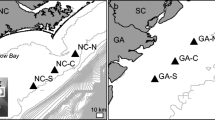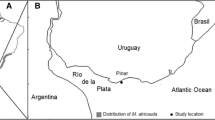Synopsis
Spawning site selection by spotted seatrout and black drum was studied by locating drumming aggregations through the use of a hydrophone. From March 1987 to October 1990, 315 sound observations were made to identify and characterize spawning seasons and environmental requirements of both species in the Barataria, Caminada, and eastern Timbalier Bay systems of Louisiana. The sounds produced by the spawning aggregations were identified and verified against known recordings. Spawning was verified on several occasions by capturing and rearing zygotes (eggs) into identifiable larvae. Spotted seatrout formed drumming aggregations from late May to early October at salinities ranging from 7.0 to 25.8 ppt and temperatures from 24.5 to 33.5° C. Black drum formed drumming aggregations between January and April in salinities from 10.0 to 27.0 ppt and temperatures from 15.0 to 24.0°C. Large drumming aggregations of spotted seatrout were located from 1800 to 2400h and from 1800 to 2200h for black drum. Spotted seatrout aggregation size was highly correlated with water temperature and for black drum with dissolved oxygen concentrations. Spawning sites for both species were frequently located in deep moving water between barrier islands as well as in channels in open water where water depth ranged from 3 to 50 m. Spawning site selection depended on a particular range of environmental conditions and spawning locations varied seasonally and yearly depending upon hydrological variation.
Similar content being viewed by others
References cited
Arnold, C.R., J.L. Lasswell, W.H. Bailey, T.D. Williams & W.A. Fable,Jr. 1978. Methods and techniques for spawning and rearing spotted seatrout in the laboratory Proceedings of the Thirteenth Annual Conference of the Southeast Association of Fish and Wildlife Agencies 30: 167–178.
Baltz, D.M. 1990. Chapter 18, Autecology. pp. 585–607. In: C.B. Schreck & P.B. Moyle (eds) Methods for Fish Biology, American Fisheries Society, Bethesda.
Barrett, B.B. 1971. Cooperative Gulf of Mexico estuarine inventory and study, Louisiana. Louisiana Wildlife and Fisheries Commission, New Orleans. 191 pp.
Bass, A.H. 1990. Sounds from the intertidal zone: vocalizing fish. BioScience 40: 249–258.
Baumann, R.H. 1987. Physical variables. pp. 8–18. In: W.H. Conner & J.W. Day, Jr. (eds) The Ecology of Barataria Basin, Louisiana: An Estuarine Profile, U.S. Fish Wildl. Serv. Biol. Rep. 85 (7. 13). 165pp.
Beckman, D.W., A.L. Stanley, J.H. Render & C.A. Wilson. 1990. Age and growth of black drum in Louisiana waters of the Gulf of Mexico. Trans. Amer. Fish. Soc. 119: 537–544.
Bovee, K.D. 1982. A guide to stream habitat analysis using the instream flow incremental methodology. U.S. Fish and Wildlife Service Biological Services Program FWS/OBS-82/26.
Bovee, K.D. & T. Cochnauer. 1977. Development and evaluation of weighted criteria, probability-of-use curves for instream flow assessments: fisheries. U.S. Fish and Wildlife Service Biological Services Program FWS/OBS-77/63.
Brown-Peterson, N.J., P. Thomas & C.R. Arnold. 1988. Reproductive biology of the spotted seatrout,Cynoscion nebulosis, in south Texas. U.S. Fish. Bull. 86: 373–388.
Burkenroad, M. 1931. Notes on the sound-producing marine fishes of Louisiana. Copeia 1931: 20–28.
Chabreck, R.H. 1972. Vegetation, water, and soil characteristics of the Louisiana coastal region. Louisiana State University, Baton Rouge. Agriculture Experiment Station Bulletin No. 664. 72 pp.
Chatry, M. & D. Chew. 1985. Freshwater diversion in coastal Louisiana: recommendations for development of management criteria. pp. 71–84. In: C.F. Bryan, P.J. Zwank & R.H. Chabreck (eds) Proceedings of the fourth coastal marsh and estuary management symposium.
Childers, D.L., J.W. Day,Jr. & R.A. Muller. 1990. Relating climatological forcing to coastal water levels in Louisiana estuaries and the potential importance of El Nino-Southern Oscillation events. Climate Research 1: 31–42.
Conner, W.H. & J.W. Day, Jr. 1987. The ecology of Barataria Basin, Louisiana: an estuarine profile. U.S. Fish and Wildlife Service Biological Report 85 (7.13). 165 pp.
Fable, W.A.,Jr., T.D. Williams & C.R. Arnold. 1978. Description of reared eggs and young larvae of the spotted seatrout,Cynoscion nebulosus. U.S. Fish. Bull. 76: 65–71.
Fish, M.P. & W.H. Mowbray. 1970. Sounds of western North Atlantic fishes. John Hopkins Press, Baltimore. 207 pp.
Fitzhugh, G.R., B.A. Thompson & T.G. Snider, III. 1992. Ovarian development, fecundity, and spawning frequency of black drum,Pogonias cromis, in Louisiana Gulf of Mexico waters. U.S. Fish. Bull. (in press).
Fontenot, B.J. & H.E. Rogillio. 1970. A study of estuarine sportfishes in the Biloxi marsh complex, Louisiana. Fisheries Bulletin, LA, Wildlife and Fisheries Commission 8: 1–72.
Frisbie, C.M. 1961. Young black drum,Pogonias cromis, in tidal, fresh, and brackish waters, especially in the Chesapeake and Delaware Bay areas. Chesapeake Science 2: 94–100.
Gray, G.A. & H.E. Winn. 1961. Reproductive ecology and sound production of the toadfishOpsanus tau. Ecology 42: 274–282.
Gray, J.D. & R.L. Colura. 1988. A preliminary analysis of the effects of temperature and salinity on hatching of spotted seatrout. Texas Parks and Wildl. Dept. Management Data Series 148: 1–8.
Guest, W.C. & J.L. Lasswell. 1978. A note on the courtship behavior and sound production of red drum. Copeia 1978: 337–338.
Gunter, G. 1938. Seasonal variations in abundance of certain estuarine and marine fishes in Louisiana, with particular reference to life histories. Ecological Monographs 8: 314–346.
Hein, S. & J. Shepard. 1979. Spawning of spotted seatrout in a Louisiana estuarine ecosystem. Proceedings of the Annual Conference of the Southeast Association of Fish & Wildlife Agencies 33: 451–465.
Hill, L.G., G.D. Schnell & W.J. Matthews. 1981. Locomotor reponses of striped bass,Morone saxatilis, to environmental variables. Amer. Midi. Nat. 105: 139–148.
Holt, G.J., S.A. Holt & C.R. Arnold. 1985. Diel periodicity of spawning in sciaenids. Mar. Ecol. Prog. Ser. 27: 1–7.
Holt, S.A., G.J. Holt & L. Young-Abel. 1988. A procedure for identifying sciaenid eggs. Contr. Mar. Sci. 30: 99–108.
Jannke, T.E. 1971. Abundance of young sciaenid fishes in Everglades National Park, Florida, in relation to season and other variables. Univ. Miami Sea Grant Program Sea Grant Technical Bulletin 11: 1–128.
Johnson, D.R. & N.A. Funicelli. 1991. Spawning of the red drum in Mosquito Lagoon, east-central Florida. Estuaries 14: 74–79.
Joseph, E.B., W.H. Massmann & J.J. Norcross. 1964. The pelagic eggs and early larval stages of the black drum from Chesapeake Bay. Copeia 1964: 425–434.
Kleinbaum, D.G., L.L. Kupper & K.E. Muller. 1988. Applied regression analysis and other multivariate methods. PWSKENT Publishing Co., Boston. 718 pp.
Luh, H.K. & H.K. Mok. 1986. Sound production in the domino damselfish,Dascyllus trimaculatus (Pomacentridae) under laboratory conditions. Jap. J. Ichthyol. 33: 70–74.
McMichael, R.H.,Jr. & K.M. Peters. 1989. Early life history of spotted seatrout (Pisces: Sciaenidae), in Tampa Bay, Florida. Estuaries 12: 98–110.
Mok, H.K. 1981. Sound production in the naked goby,Gabiosomi bosci (Pisces, Gobiidae) — a preliminary study. pp. 447–458. In: W.N. Tavolga, A.N. Popper & R.R. Fay (eds) Hearing and Sound Communication in Fishes. Springer-Verlag, New York.
Mok, H.K. & R.G. Gilmore. 1983. Analysis of sound production in estuarine aggregations ofPogonias cromis, Bairdiella chrysoura, andCynoscion nebulosus (Sciaenidae). Bulletin of the Institute of Zoology, Academia Sinica (Taipei) 22: 157–186.
Murphy, M.D. & R.G. Taylor. 1989. Reproduction and growth of black drum,Pogonias cromis, in northeast Florida. Northeast Gulf Sci. 10: 127–137.
Myrberg, A.A.,Jr. & R.J. Riggio. 1985. Acoustically mediated individual recognition by a coral reef fish (Pomacentrus partitus). Animal Behavior 33: 411–416.
Neter, J., W. Wasserman & M.H. Kutner. 1989. Applied linear regression models. Second edition. R.D. Irwin, Boston. 667 pp.
Pearson, J.C. 1929. Natural history and conservation of the redfish and the commercial sciaenids on the Texas Coast. U.S. Bur. Fish. Bull. 44: 129–214.
Peebles, E.B. & S.G. Tolley. 1988. Distribution, growth, and mortality of larval spotted seatrout,Cynoscion nebulosus: a comparison between two adjacent estuarine areas of southwest Florida. Bull. Mar. Sci. 42: 397–410.
Peters, K.M. & R.H. McMichael,Jr. 1990. Early life history of the black drumPogonias cromis (Pisces: Sciaenidae) in Tampa Bay, Florida. Northeast Gulf Sci. 11: 39–58.
Powell, A.B., D.E. Hoss, W.F. Hettler, D.S. Peters & S. Wagner. 1989. Abundance and distribution of ichthyoplankton in Florida Bay and adjacent waters. Bull. Mar. Sci. 44: 35–48.
Rakocinski, C., D.M. Baltz & J.W. Fleeger. 1992. Correspondence between environmental gradients and the community structure of marsh-edge fishes in a Louisiana estuary. Mar. Ecol. Prog. Ser. 80: 135–148.
Rogillio, H.E. 1975. An estuarine sportfish study in southeastern Louisiana. Fisheries Bulletin Number 14, Louisiana Wildlife and Fisheries Commission, New Orleans. 71 pp.
Rutherford, E.S., T.W. Schmidt & J.T. Tilmant. 1989a. Early life history of spotted seatrout (Cynoscion nebulosus) and gray snapper (Lutjanus griseus) in Florida Bay, Everglades National Park, Florida. Bull. Mar. Sci. 44: 49–64.
Rutherford, E.S., J.T. Tilmant, E.B. Thue & T.W. Schmidt. 1989b. Fishery harvest and population dynamics of spotted seatrout,Cynoscion nebulosus, in Florida Bay and adjacent waters. Bull. Mar. Sci. 44: 108–125.
Sabins, D.S. & F.M. Truesdale. 1975. Diel and seasonal occurrence of immature fishes in a Louisiana tidal pass. Proc. Annu. Conf. Southeast. Assoc. Game and Fish Comm. 28: 161–171.
SAS Institute Incorporated. 1985. SAS user's guide: statistics, version 5 edition, Cary. 956 pp.
Simmons, E.G. & J.P. Breuer. 1962. A study of redfish,Sciaenops ocellata Linnaeus, and black drum,Pogonias cromis Linnaeus. Publ. Inst. Mar. Sci. Univ. Texas 8: 184–211.
Sundararaj, B.I. & R.D. Suttkus. 1962. Fecundity of the spotted seatroutCynoscion nebulosus (Cuvier) from Lake Borgne area, LA. Trans. Amer. Fish. Soc. 91: 84–88.
Tabb, D.C. 1961. A contribution to the biology of the spotted seatrout,Cynoscion nebulosus (Cuvier), of East-Central Florida. Florida State Board of Conservation, Marine Research Lab, Technical Series 35: 1–24.
Tabb, D.C. 1966. The estuary as a habitat for spotted seatroutCynoscion nebulosus. Amer. Fish. Soc. Special Publication 3: 59–67.
Tabb, D.C. & R.B. Manning. 1961. A checklist of the flora and fauna of northern Florida Bay and adjacent brackish waters of the Florida mainland collected during the period July, 1957 through September, 1960. Bulletin of Marine Science Gulf and Caribbean 11: 552–649.
Tavolga, W.N. 1971. Sound production and detection. pp.135–235. In: W.S. Hoar & D.J. Randall (eds) Fish Physiology, Vol. 5, Academic Press, New York.
Tavolga, W.N. 1980. Hearing and sound communication in fishes in relation to fisheries management. pp. 102–123. In: J.E. Bardach, J.J. Magnuson, R.C. May & J.M. Reinhart (eds) Fish Behavior and Its Use in the Capture and Culture of Fishes, ICLARM Conference Proceedings 5, Manilla.
Tower, R.W. 1908. The production of sound in the drumfishes, the searobin and the toadfish. Ann. N.Y. Acad. Sci. 18: 148–180.
Tucker, J.W.,Jr. & B.E. Faulkner. 1987. Voluntary spawning patterns of captive spotted seatrout. Northeast Gulf Sci. 9: 59–63.
Weiting, D.S. 1989. Age. growth, and fecundity of the spotted seatrout (Cynoscion nebulosus) in Louisiana. M.S. Thesis, Louisiana State University, Baton Rouge. 93 pp.
Author information
Authors and Affiliations
Additional information
Correspondence to D.M. Baltz
Rights and permissions
About this article
Cite this article
Saucier, M.H., Baltz, D.M. Spawning site selection by spotted seatrout,Cynoscion nebulosus, and black drum,Pogonias cromis, in Louisiana. Environ Biol Fish 36, 257–272 (1993). https://doi.org/10.1007/BF00001722
Received:
Accepted:
Issue Date:
DOI: https://doi.org/10.1007/BF00001722




